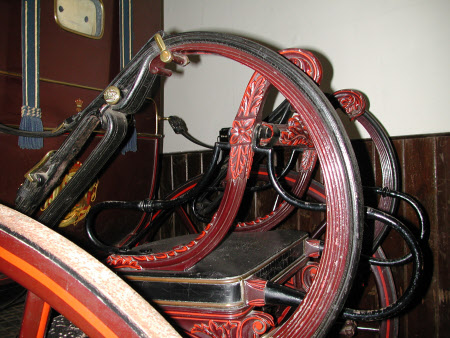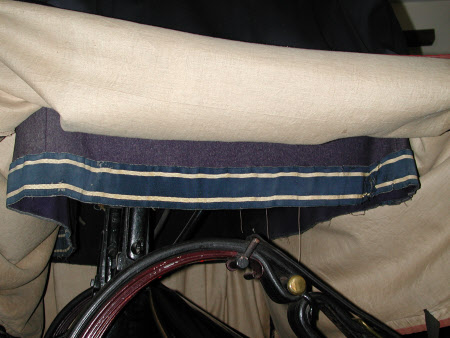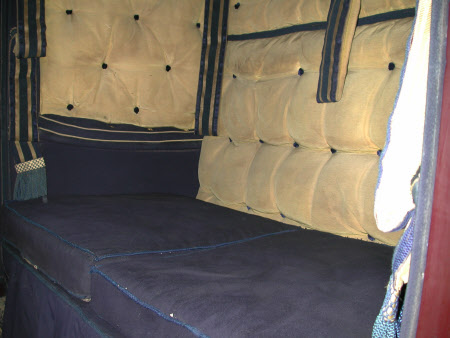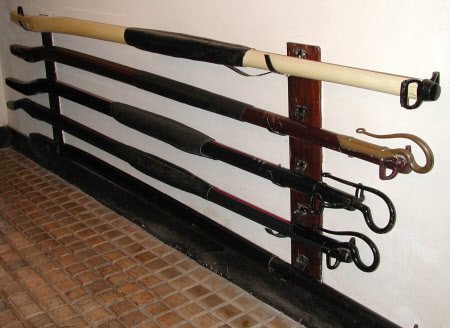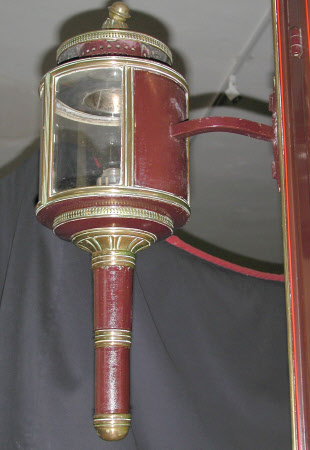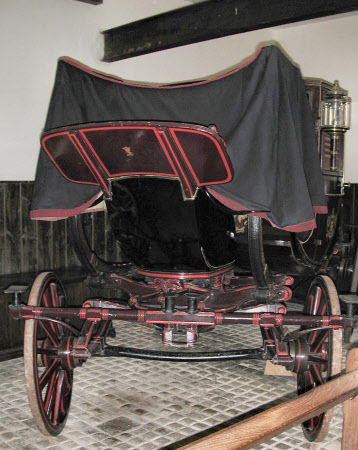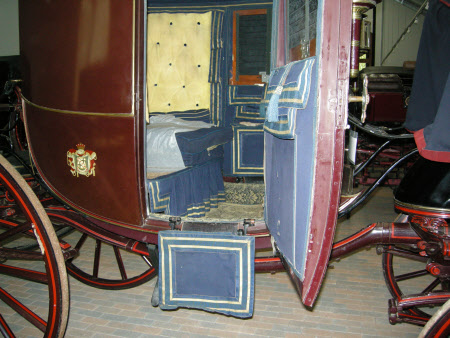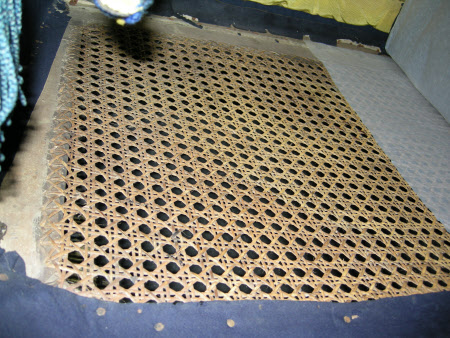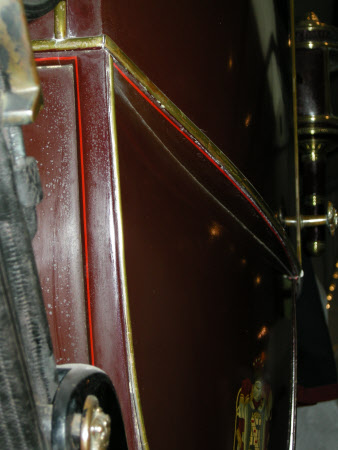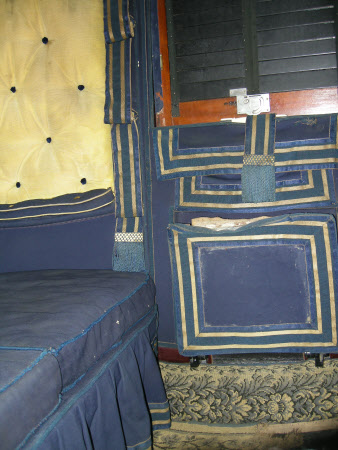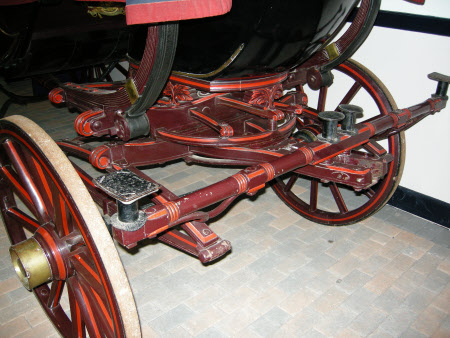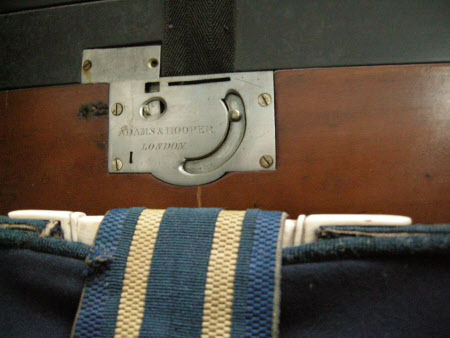State chariot
Hooper and Co.
Category
Carriages & other vehicles
Date
circa 1840
Materials
Glass, Ivory, Leather, Metal, Textile, Wood
Measurements
2290 x 2040 mm; 4577 mm (Length)19 cwt (Wt)
Place of origin
London
Order this imageCollection
National Trust Carriage Museum
NT 272890
Summary
State Chariot built for the Earl of Onslow by Hooper and Co, London, circa 1840.
Full description
On C and under springs with compassed, plated perch. Salisbury boot and hammer cloth set. Footman’s cushion and hind standards. With centre pole and on C and under springs. In maroon livery and red lining with the Onslow Coat of Arms on side panels, rear and front 'Festina Lente' - 'Hasten with Caution'. Gold and blue interior trim with two cushions. This carriage was built for the Earl of Onslow of Clandon Park, Surrey (now a National Trust property), by Adams & Hooper of London. They were in business from 1830 to 1846, so it was built between these dates. It was used only on state occasions and was driven by a coachman in full livery with powdered wig, tricorn hat, braided livery coat, white plush breeches, white silk stockings and silver-buckled shoes. Two footmen, similarly dressed, except that they wore bicorn or cocked hats, stood on the “footmen’s cushion”, the padded platform behind the body, steadying themselves with the “footmen’s holders”. They carried silver-topped staves, known as wands, which were earlier used to keep the crowds away from the carriage. They were expected to stand motionless and bolt upright. Unfortunately the hammer cloth is missing, so this chariot is displayed with a hammer cloth cover. CJN 13.11.07 BODY Typical chariot body with outside elbows, leather covered roof. Salisbury boot on foliage carved blocks supporting hammer cloth seat (hammer cloth missing). Straight footboard on moulded brackets with foliage carved ends. Footman’s cushion on deep scroll carved blocks, hind standards with foliate carving including crossbar with foliate carved cartouche. Undecorated black painted body loops with Earl’s coronet on heads of bolts. Doors Doors on three butt hinges with pierced brass T handle with Earl’s coronet on central boss. Budget lock beneath handle. Steps Double folding steps at doors. Rectangular jagged plate step treads on outer roller bolts. Oval jagged plate steps on stays from Salisbury boot. Two oval jagged plate stepson step iron that can be removed from the near side end of hind spring bed. Windows Window in each door and two front windows, frames covered with blue velvet bleached to brown on the outside. Venetian blinds at all windows secured with lock. Rectangular back light with radiused corners. Lamps Cylindrical lamps with singular tier circular pagoda tops. Candle holder with three triple brass bands. Lamps supported on square irons bolted to front pillars. External Furniture 1/2 round pin bead surrounding all lower panels and door frame with moulded brass bead around roof edge. 3 head plates on each upper ¼ panel (crests missing on offside panel) CARRIAGE Wheels 12 and 14 spoke English pattern wheels with flat iron tyres, brass stock hoops and axle caps. Axles Collinges patent axles compassed down. Hind axle cranked down adjacent to under springs Springs C springs and under springs with moulded wood cappings to dumb irons. Under springs clipped to axles. Fore carriage Close futchell fore carriage with straight transom and axle bed and compassed horn bar. Full wheel plate and no sway bar. Turned splinter bar. Circular carved fiddle ends on beds, futchells and framing pieces. POLE Perch Perch and wings bolted beneath hind axle bed and morticed through hind spring bed. Hind carriage Hind carriage with carved fiddle ends on beds and framing pieces to match those on fore carriage Brake No break. Hook on perch for drag shoe chain. No drag shoe and no hook to hang it on when not in use. Paint Body, wheels and carriage – maroon. Fine red line on body frame mouldings. Broad red line on wheels, springs and carriage. Carvings picked out in red. Venetian blind louvers black with broad red band in varnished mahogany frame. Heraldry Coat of arms on door panels, lower quarter panels and lower front and back panels. Crest surmounted by coronet on fence rail panels and front and back mid panels and beneath footboard. Leather Leather covered Salisbury boot, main spring braces in two components with C spring bases and separate buckled loop braces. Collar braces with leather covered buckles. Check braces front and back. Leather covered footman’s cushion. Roller bolt leathers. POLE. Coachman’s heel leather missing. External Trimming Footboard covered with welted floor cloth. Hammer cloth missing. Blue faced wool cloth hammer cloth cover with red worsted tape top and bottom. Very shallow inner hammer cloth cover of coarse blue wool cloth edged with worsted broad lace – to match internal laces. Two broad lace footman’s holders double sided with two gold stripes on dark blue ground and blue wool tassels, colours to match inner laces, and two missing. Two webbing footman’s holders. Internal Trimming Seat back, upper back squab and upper ¼ squabs pale yellow ribbed silk with blue wool tufts. Roof lining, front, side and door linings, seat cushions and seat fall dark blue faced wool cloth. Seat base woven split cane. Broad laces on door pockets, pocket flaps, step pads and seat fall edging. Two triple loop holders, four swing holders. Dark blue worsted stripes on gold and royal blue worsted ground. No spring curtains or provision for them. Floral patterned loop pile carpet in shades of blue on a cream ground. Carpet runner to match on step treads. Risers dark blue double sided welted morocco. Internal Furniture Hole in pillar between front windows for coachman’s communication cord – cord missing. Ivory glass string slides and knobs.
Makers and roles
Hooper and Co., coach builder

